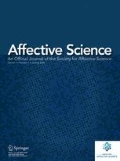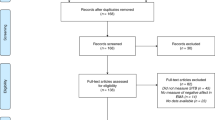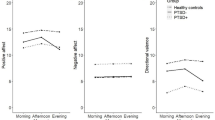Abstract
We still have little understanding of short-term predictors of suicidal thoughts and behaviors (STBs). Prior research links increased negative affect to STBs, but the vast majority of earlier work is limited by measuring negative affect at one time point and aiming to predict STBs months or years in the future. Recently, intensive longitudinal studies have shown that negative affect is associated with suicidal thoughts over relatively short, clinically useful time periods; however, the specific patterns and types of negative affect that predict STBs remain unclear. Using ecological momentary assessment (EMA) data from psychiatric inpatients hospitalized for suicide risk (n = 83), this study sought to test whether the patterns (means and variability) of two types of negative affect (anxiety/agitation and shame/self-hatred, which were derived from a larger EMA battery) during hospitalization predict STBs in the 4 weeks after discharge: an extremely high-risk time for suicidal behavior. The mean—but not the variability—of both anxiety/agitation and shame/self-hatred during hospitalization predicted the number of days with suicidal thoughts after discharge. The mean and the variability of shame/self-hatred—but not anxiety/agitation—predicted post-discharge suicide attempt. We discuss implications for assessment and treatment of suicidal individuals and propose key directions for future research.


Similar content being viewed by others
Notes
In both study waves, the second question of the 4-week follow-up survey (“about how many days in the past four weeks did you think of killing yourself?”) had an error such that the maximum number of days participants could enter was 14 (not 28). Thus, we did not analyze the “how many days” question from the 4-week follow-up.
We operationalized variability with SD instead of RMSSD or other more complex metrics for two reasons. (1) The convention is to require more data points (e.g., 20 in Dejonckheere et al., 2019) than we had here to calculate more complex, time-dependent affective metrics, whereas SD is not time-dependent (Trull et al., 2015). To reliably estimate the RMSSD, we would have needed to restrict to only those participants who completed higher numbers of EMA surveys which would have biased our sample and considerably reduced our N. (2) SD and RMSSD overlap and are highly correlated (e.g., Hisler et al., 2020; Wendt et al., 2019), and we were more interested in the relationship of NA variability with STBs rather than the unique effects of one index of variability when controlling for another.
In two additional sensitivity analyses, (1) when excluding the 5 participants who did not complete the two-week follow-up but denied suicidal thoughts since discharge on the 4-week follow-up, the same findings also held. (2) When excluding participants who completed fewer than 10 EMA surveys, only mean levels of shame/self-hatred (not anxiety/agitation) predicted days with suicidal thoughts.
When excluding the 5 participants coded as non-attempters based only on 2-week (not four-week) follow-up survey data, and when excluding participants who completed fewer than 10 EMA surveys, the same findings held.
References
Abramson, L. Y., Alloy, L. B., Hogan, M. E., Whitehouse, W. G., Hankin, B. L., & Cornette, M. M. (2000). The hopelessness theory of suicidality. In In T. E. Joiner & M. D. Rudd (Eds.), Suicide science: Expanding the boundaries (pp. 17–32). Kluwer Academic/Plenum Publishers.
Bakdash, J. Z., & Marusich, L. R. (2020). Repeated measures correlation (0.4.1) [Computer software].
Baumeister, R. F. (1990). Suicide as escape from self. Psychological Review, 97(1), 90–113. https://doi.org/10.1037/0033-295X.97.1.90
Beck, A. T. (1967). Depression: Clinical, experimental, and theoretical aspects. Harper & Row.
Ben-Zeev, D., Young, M. A., & Depp, C. A. (2012). Real-time predictors of suicidal ideation: Mobile assessment of hospitalized depressed patients. Psychiatry Research, 197(1–2), 55–59. https://doi.org/10.1016/j.psychres.2011.11.025
Berner, L. A., Crosby, R. D., Cao, L., Engel, S. G., Lavender, J. M., Mitchell, J. E., & Wonderlich, S. A. (2017). Temporal associations between affective instability and dysregulated eating behavior in bulimia nervosa. Journal of Psychiatric Research, 92, 183–190. https://doi.org/10.1016/j.jpsychires.2017.04.009
Bürkner, P.-C. (2017). brms: An R package for Bayesian multilevel models using Stan. Journal of Statistical Software, 80(1). https://doi.org/10.18637/jss.v080.i01
Busch, K. A., Fawcett, J., & Jacobs, D. G. (2003). Clinical correlates of inpatient suicide. The Journal of Clinical Psychiatry, 64(1), 14–19.
Cameron, A. Y., Shea, M. T., & Randall, A. B. (2020). Acute shame predicts urges for suicide but not for substance use in a veteran population. Suicide and Life-Threatening Behavior, 50(1), 292–299. https://doi.org/10.1111/sltb.12588
Centers for Disease Control. (2021). Changes in Suicide Rates—United States, 2019-2019 [Morbidity and Mortality Weekly Report]. US Department of Health and Human Services. https://www.cdc.gov/mmwr/volumes/70/wr/pdfs/mm7008a1-H.pdf
Chung, D., Hadzi-Pavlovic, D., Wang, M., Swaraj, S., Olfson, M., & Large, M. (2019). Meta-analysis of suicide rates in the first week and the first month after psychiatric hospitalisation. British Medical Journal Open, 9(3), e023883. https://doi.org/10.1136/bmjopen-2018-023883
Chung, D. T., Ryan, C. J., Hadzi-Pavlovic, D., Singh, S. P., Stanton, C., & Large, M. M. (2017). Suicide rates after discharge from psychiatric facilities: A systematic review and meta-analysis. JAMA Psychiatry, 74(7), 694. https://doi.org/10.1001/jamapsychiatry.2017.1044
Dejonckheere, E., Mestdagh, M., Houben, M., Rutten, I., Sels, L., Kuppens, P., & Tuerlinckx, F. (2019). Complex affect dynamics add limited information to the prediction of psychological well-being. Nature Human Behaviour, 3(5), 478–491. https://doi.org/10.1038/s41562-019-0555-0
Dejonckheere, E., Mestdagh, M., Kuppens, P., & Tuerlinckx, F. (2020). Reply to: Context matters for affective chronometry. Nature Human Behaviour. https://doi.org/10.1038/s41562-020-0861-6
Depaoli, S., & van de Schoot, R. (2017). Improving transparency and replication in Bayesian statistics: The WAMBS-Checklist. Psychological Methods, 22(2), 240–261. https://doi.org/10.1037/met0000065
Ebner-Priemer, U. W., & Sawitzki, G. (2007). Ambulatory assessment of affective instability in borderline personality disorder. European Journal of Psychological Assessment, 23(4), 238–247. https://doi.org/10.1027/1015-5759.23.4.238
Fawcett, J., Scheftner, W. A., Fogg, L., Clark, D. C., Young, M. A., Hedeker, D., & Gibbons, R. (1990). Time-related predictors of suicide in major affective disorder. The American Journal of Psychiatry, 147(9), 1189–1194. https://doi.org/10.1176/ajp.147.9.1189
Franklin, J. C., Ribeiro, J. D., Fox, K. R., Bentley, K. H., Kleiman, E. M., Huang, X., Musacchio, K. M., Jaroszewski, A. C., Chang, B. P., & Nock, M. K. (2017). Risk factors for suicidal thoughts and behaviors: A meta-analysis of 50 years of research. Psychological Bulletin, 143(2), 187–232. https://doi.org/10.1037/bul0000084
Gelman, A., Carlin, J. B., Stern, H. S., Dunson, D. B., Vehtari, A., & Rubin, D. (2014). Bayesian data analysis (Vol. 2). CRC Press.
Glenn, C. R., & Nock, M. K. (2014). Improving the short-term prediction of suicidal behavior. American Journal of Preventive Medicine, 47(3 Suppl 2), S176. https://doi.org/10.1016/j.amepre.2014.06.004
Hall, D. B. (2000). Zero-inflated Poisson and binomial regression with random effects: A case study. Biometrics, 56(4), 1030–1039. https://doi.org/10.1111/j.0006-341X.2000.01030.x
Hall, R. C. W., Platt, D. E., & Hall, R. C. W. (1999). Suicide risk assessment: A review of risk factors for suicide in 100 patients who made severe suicide attempts. Psychosomatics, 40(1), 18–27. https://doi.org/10.1016/S0033-3182(99)71267-3
Hallensleben, N., Glaesmer, H., Forkmann, T., Rath, D., Strauss, M., Kersting, A., & Spangenberg, L. (2019). Predicting suicidal ideation by interpersonal variables, hopelessness and depression in real-time. An ecological momentary assessment study in psychiatric inpatients with depression. European Psychiatry, 56(1), 43–50. https://doi.org/10.1016/j.eurpsy.2018.11.003
Hastings, M. E., Northman, L. M., & Tangney, J. P. (2000). Shame, guilt, and suicide. In Suicide science: Expanding the boundaries. (In: Joiner T, Rudd DM, editors., pp. 67–79). Kluwer Academic/Plenum Publishers.
Hisler, G. C., Krizan, Z., DeHart, T., & Wright, A. G. C. (2020). Neuroticism as the intensity, reactivity, and variability in day-to-day affect. Journal of Research in Personality, 87, 103964. https://doi.org/10.1016/j.jrp.2020.103964
Humber, N., Emsley, R., Pratt, D., & Tarrier, N. (2013). Anger as a predictor of psychological distress and self-harm ideation in inmates: A structured self-assessment diary study. Psychiatry Research, 210(1), 166–173. https://doi.org/10.1016/j.psychres.2013.02.011
Husky, M., Swendsen, J., Ionita, A., Jaussent, I., Genty, C., & Courtet, P. (2017). Predictors of daily life suicidal ideation in adults recently discharged after a serious suicide attempt: A pilot study. Psychiatry Research, 256, 79–84. https://doi.org/10.1016/j.psychres.2017.06.035
Joiner, T. (2005). Why people die by suicide. Harvard University Press.
Kleiman, E. M., Coppersmith, D. D. L., Millner, A. J., Franz, P. J., Fox, K. R., & Nock, M. K. (2018). Are suicidal thoughts reinforcing? A preliminary real-time monitoring study on the potential affect regulation function of suicidal thinking. Journal of Affective Disorders, 232, 122–126. https://doi.org/10.1016/j.jad.2018.02.033
Kleiman, E. M., Turner, B. J., Fedor, S., Beale, E. E., Huffman, J. C., & Nock, M. K. (2017). Examination of real-time fluctuations in suicidal ideation and its risk factors: Results from two ecological momentary assessment studies. Journal of Abnormal Psychology, 126(6), 726–738. https://doi.org/10.1037/abn0000273
Kruschke, J. K. (2015). Doing Bayesian data analysis: A tutorial with R, JAGS, and Stan (2nd ed.). Elsevier Inc
Kruschke, J. K., & Liddell, T. M. (2018). The Bayesian New Statistics: Hypothesis testing, estimation, meta-analysis, and power analysis from a Bayesian perspective. Psychonomic Bulletin & Review, 25(1), 178–206. https://doi.org/10.3758/s13423-016-1221-4
Linehan, M. (1993). Cognitive-behavioral treatment of borderline personality disorder. Guilford Press.
Links, P. S., Eynan, R., Heisel, M. J., Barr, A., Korzekwa, M., McMain, S., & Ball, J. S. (2007). Affective instability and suicidal ideation and behavior in patients with borderline personality disorder. Journal of Personality Disorders, 21(1), 72–86. https://doi.org/10.1521/pedi.2007.21.1.72
Lüdecke, D. (2020). sjPlot: Data visualization for statistics in social science (2.8.4) [Computer software]. https://CRAN.R-project.org/package=sjPlot
Makowski, D., Ben-Shachar, M., & Lüdecke, D. (2019a). bayestestR: Describing effects and their uncertainty, existence and significance within the Bayesian framework. Journal of Open Source Software, 4(40), 1541. https://doi.org/10.21105/joss.01541
Makowski, D., Ben-Shachar, M. S., Chen, S. H. A., & Lüdecke, D. (2019b). Indices of effect existence and significance in the Bayesian framework. Frontiers in Psychology, 10. https://doi.org/10.3389/fpsyg.2019.02767
Maltsberger, J. T. (2004). The descent into suicide. The International Journal of Psychoanalysis, 85(3), 653–668. https://doi.org/10.1516/3C96-URET-TLWX-6LWU
Maltsberger, J. T., Goldblatt, M. J., Ronningstam, E., Weinberg, I., & Schechter, M. (2011). Traumatic subjective experiences invite suicide. The Journal of the American Academy of Psychoanalysis and Dynamic Psychiatry, 39(4), 671–693. https://doi.org/10.1521/jaap.2011.39.4.671
Mou, D., Kleiman, E. M., Fedor, S., Beck, S., Huffman, J. C., & Nock, M. K. (2018). Negative affect is more strongly associated with suicidal thinking among suicidal patients with borderline personality disorder than those without. Journal of Psychiatric Research, 104, 198–201. https://doi.org/10.1016/j.jpsychires.2018.08.006
Nahum-Shani, I., Smith, S. N., Spring, B. J., Collins, L. M., Witkiewitz, K., Tewari, A., & Murphy, S. A. (2018). Just-in-time adaptive interventions (JITAIs) in mobile health: Key components and design principles for ongoing health behavior support. Annals of Behavioral Medicine, 52(6), 446–462. https://doi.org/10.1007/s12160-016-9830-8
Nock, M. K., Hwang, I., Sampson, N. A., & Kessler, R. C. (2010a). Mental disorders, comorbidity and suicidal behavior: Results from the National Comorbidity Survey Replication. Molecular Psychiatry, 15(8), 868–876. https://doi.org/10.1038/mp.2009.29
Nock, M. K., Park, J. M., Finn, C. T., Deliberto, T. L., Dour, H. J., & Banaji, M. R. (2010b). Measuring the suicidal mind: Implicit cognition predicts suicidal behavior. Psychological Science, 21(4), 511–517. https://doi.org/10.1177/0956797610364762
Olfson, M. (2017). Suicide risk after psychiatric hospital discharge. JAMA Psychiatry, 74(7), 669. https://doi.org/10.1001/jamapsychiatry.2017.1043
Palmier-Claus, J.E., Shryane, N., Taylor, P., Lewis, S., and Drake, R. (2013). “Mood Variability Predicts the Course of Suicidal Ideation in Individuals with First and Second Episode Psychosis.” Psychiatry Research, 206, (2–3), 240–45. https://doi.org/10.1016/j.psychres.2012.11.014
Palmier-Claus, J. E., Taylor, P. J., Varese, F., & Pratt, D. (2012b). Does unstable mood increase risk of suicide? Theory, research and practice. Journal of Affective Disorders, 143(1–3), 5–15. https://doi.org/10.1016/j.jad.2012.05.030
Qin, P., & Nordentoft, M. (2005). Suicide risk in relation to psychiatric hospitalization: Evidence based on longitudinal registers. Archives of General Psychiatry, 62(4), 427. https://doi.org/10.1001/archpsyc.62.4.427
R Core Team. (2019). R: A language and environment for statistical computing. R Foundation for Statistical Computing.
Ribeiro, J. D., Franklin, J. C., Fox, K. R., Bentley, K. H., Kleiman, E. M., Chang, B. P., & Nock, M. K. (2016). Self-injurious thoughts and behaviors as risk factors for future suicide ideation, attempts, and death: A meta-analysis of longitudinal studies. Psychological Medicine, 46(2), 225. https://doi.org/10.1017/S0033291715001804
Rogers, M. L., Ringer, F. B., & Joiner, T. E. (2016). A meta-analytic review of the association between agitation and suicide attempts. Clinical Psychology Review, 48, 1–6. https://doi.org/10.1016/j.cpr.2016.06.002
Sheehy, K., Noureen, A., Khaliq, A., Dhingra, K., Husain, N., Pontin, E. E., Cawley, R., & Taylor, P. J. (2019). An examination of the relationship between shame, guilt and self-harm: A systematic review and meta-analysis. Clinical Psychology Review, 73, 101779. https://doi.org/10.1016/j.cpr.2019.101779
Shepard, D. S., Gurewich, D., Lwin, A. K., Reed, G. A., & Silverman, M. M. (2016). Suicide and suicidal attempts in the United States: Costs and policy implications. Suicide and Life-Threatening Behavior, 46(3), 352–362. https://doi.org/10.1111/sltb.12225
Shneidman, E. S. (1993). Commentary: Suicide as psychache: The Journal of Nervous and Mental Disease, 181(3), 145–147. https://doi.org/10.1097/00005053-199303000-00001
Statistics|Suicide|Violence Prevention|Injury Center|CDC. (2018, September 7). https://www.cdc.gov/violenceprevention/suicide/statistics/index.html
Trull, T. J., Lane, S. P., Koval, P., & Ebner-Priemer, U. W. (2015). Affective dynamics in psychopathology. Emotion Review, 7(4), 355–361. https://doi.org/10.1177/1754073915590617
Victor, S. E., Brown, S. L., & Scott, L. N. (2021). Prospective and concurrent affective dynamics in self-injurious thoughts and behaviors: An examination in young adult women. Behavior Therapy. https://doi.org/10.1016/j.beth.2021.01.003
Watson, D., Clark, L. A., & Tellegen, A. (1988). Development and validation of brief measures of positive and negative affect: The PANAS scales. Journal of Personality and Social Psychology, 54(6), 1063–1070.
Wendt, L. P., Wright, A. G. C., Pilkonis, P. A., Woods, W. C., Denissen, J. J. A., Kühnel, A., & Zimmermann, J. (2019). Indicators of affect dynamics: Structure, reliability, and personality correlates [Preprint]. PsyArXiv. https://doi.org/10.31234/osf.io/nyqst
Wolak, M. (2017). Facilitating estimation of the intraclass correlation coefficient. https://github.com/matthewwolak/ICC
Author information
Authors and Affiliations
Corresponding author
Ethics declarations
Funding
This research was funded by grant K23 MH120436 (KHB) from the National Institute of Mental Health, and the Chet and Will Griswold Suicide Prevention Fund (MKN).
Data Availability
The code and de-identified data used for the present study are available at https://osf.io/3h7m4/.
Code Availability
Code is available from the corresponding author on request.
Ethics Approval
All procedures performed in this study involving human participants were approved by the Institutional Review Board at the Massachusetts General Hospital (IRB# 2015P000598) with reliance agreements established with other involved institutions.
Conflict of Interest
The authors declare no competing interests. Dr Nock receives publication royalties from Macmillan, Pearson, and UpToDate. He has been a paid consultant in the past year for Microsoft Corporation, the Veterans Health Administration, Cerebral, and for a legal case regarding a death by suicide. He is an unpaid scientific advisor for Empatica, Koko, and TalkLife.
Informed Consent
Informed consent was obtained from all individual participants included in the study.
Preregistration
The analyses conducted here were not formally pre-registered.
Supplementary Information
The online version contains supplementary material available at https://doi.org/10.1007/s42761-021-00058-6.
Author Contribution
KHB: conceptualization, methodology, investigation, formal analysis, writing–original draft/review and editing, visualization, funding. DDL: conceptualization, methodology, formal analysis, writing–review and editing, visualization. EMK: conceptualization, methodology, investigation, project administration, writing–review and editing. ECK: conceptualization, writing–review and editing. PM: methodology, software, formal analysis, writing–review and editing. AJM: investigation, writing–review and editing. ARR: writing–original draft/review and editing. SBW: writing–review and editing. RGF: writing–review and editing. MBS: investigation, writing–review and editing. SB: investigation, writing–review and editing. JCH: investigation, project administration, writing–review and editing. MKN: conceptualization, methodology, investigation, writing–review and editing, project administration, funding.
Additional information
Handling editor: Wendy Berry Mendes
Supplementary Information
Below is the link to the electronic supplementary material.
Rights and permissions
About this article
Cite this article
Bentley, K.H., Coppersmith, D.L., Kleiman, E.M. et al. Do Patterns and Types of Negative Affect During Hospitalization Predict Short-Term Post-Discharge Suicidal Thoughts and Behaviors?. Affec Sci 2, 484–494 (2021). https://doi.org/10.1007/s42761-021-00058-6
Received:
Accepted:
Published:
Issue Date:
DOI: https://doi.org/10.1007/s42761-021-00058-6




